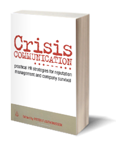Nothing is more important in PR or marketing than getting the targeting right. Understanding who the right audience is and knowing how to reach them is one of the first things to undertake and will be a key factor on how effective and efficient your campaign will be.
So I read with interest an article that talked of the the targeting potential of LinkedIn last week in Advertising Age.
Highlights from the study:
* 30 million current members
* 8.4 million (24 percent) members are senior executives with a mean salary of $104,100
* 1/3 of members are savvy networkers with an average of 61 connections (the overall average is 38) and personal income of more than $90,000
* 21 percent of members are seeking job opportunities
OK, so we all knew LinkedIn members used the site for business reasons -- vs. the more purely social networks such as Facebook or MySpace – but we didn't know exactly who they were.
Now we do.
Certainly a very aspiring group of people and they are neatly grouped so theoretically easier to target. The problem I have now, is how can PR utilize that nugget of information. Sure some can afford to place a banner advert on LinkedIn – but where is the potential for PR?
I don’t have the answer just yet – but think the question is worth considering…. Please do let me know if you think you have an answer.
Sunday, November 16, 2008
Tuesday, November 11, 2008
Seven rules of crisis management
OK - so first off I am pretty proud that I'm a co-author on the new Crisis Communications book.
‘Crisis Communication: Practical PR Strategies for Reputation Management and Company Survival’ (ISBN: 978-0749454005)
This new book by the publishers Kogan Page is a joint work by 20 international authors - and that's what I think makes it special.
No company or organization is immune to crisis. A crisis, however, does not necessarily have to turn into a PR disaster. Crisis Communications provides readers with advice on how to limit damage by acting quickly and positively. Moreover, it explains how to turn a crisis into an opportunity by communicating efficiently via a successful public relations strategy.
Crisis Communications is a thorough guide to help prepare an organization for unexpected calamities. It provides information on accountability, planning, building corporate image, natural disasters, accidents, financial crises, legal issues, corporate re-organization, food crises, negative press, media training and risk managers.
As I start the publicity for this book, I am being asked to summaries the 200+ pages into 300 words... so here goes...
1. People - The team involved in managing crisis communications should be fully briefed on who will contact who in the event of a crisis, and which method of contact they will use.
2. Roles and tasks - Have a checklist of what role each team member will fulfil during the crisis, and what tasks they are assigned as the crisis breaks, during the crisis and afterwards. Suggested roles include: briefing members of the board; internal communications and keeping staff informed; media relations; media monitoring; and online monitoring.
3. Messages - Work out in advance the key messages you will want to communicate in a crisis. Don’t bother with corporate messages about visions and mission statements – journalists aren’t interested in these. Think about what messages you want to get across about which journalists will realistically write.
4. Draft statements and responses - Having template statements ready prepared can help you turn things around quickly when a crisis breaks. Have background facts and Q&As about the company ready and to hand.
5. Speed - You need speed of response, but also speed of thinking and actions to be in control of the situation, rather than panicking to catch up with the media. You want to run the pace of the story your way and have the -media responding to you, rather than the other way around.
6. Control - Work out how you will take control of the story for each likely scenario. The plan should identify media-trained spokespeople who can talk in a crisis. Have some ready-prepared images available. If you don’t, the media may look elsewhere to fill the gap.
7. Practice - Teams need to be familiar with the crisis comms plan. NettResults recommends crisis training twice a year and a simulation exercise at least once a year.
And if asked to define it in 6 words...
Conflict builds character - crisis defines it.
‘Crisis Communication: Practical PR Strategies for Reputation Management and Company Survival’ (ISBN: 978-0749454005)
This new book by the publishers Kogan Page is a joint work by 20 international authors - and that's what I think makes it special.
No company or organization is immune to crisis. A crisis, however, does not necessarily have to turn into a PR disaster. Crisis Communications provides readers with advice on how to limit damage by acting quickly and positively. Moreover, it explains how to turn a crisis into an opportunity by communicating efficiently via a successful public relations strategy.
Crisis Communications is a thorough guide to help prepare an organization for unexpected calamities. It provides information on accountability, planning, building corporate image, natural disasters, accidents, financial crises, legal issues, corporate re-organization, food crises, negative press, media training and risk managers.
As I start the publicity for this book, I am being asked to summaries the 200+ pages into 300 words... so here goes...
1. People - The team involved in managing crisis communications should be fully briefed on who will contact who in the event of a crisis, and which method of contact they will use.
2. Roles and tasks - Have a checklist of what role each team member will fulfil during the crisis, and what tasks they are assigned as the crisis breaks, during the crisis and afterwards. Suggested roles include: briefing members of the board; internal communications and keeping staff informed; media relations; media monitoring; and online monitoring.
3. Messages - Work out in advance the key messages you will want to communicate in a crisis. Don’t bother with corporate messages about visions and mission statements – journalists aren’t interested in these. Think about what messages you want to get across about which journalists will realistically write.
4. Draft statements and responses - Having template statements ready prepared can help you turn things around quickly when a crisis breaks. Have background facts and Q&As about the company ready and to hand.
5. Speed - You need speed of response, but also speed of thinking and actions to be in control of the situation, rather than panicking to catch up with the media. You want to run the pace of the story your way and have the -media responding to you, rather than the other way around.
6. Control - Work out how you will take control of the story for each likely scenario. The plan should identify media-trained spokespeople who can talk in a crisis. Have some ready-prepared images available. If you don’t, the media may look elsewhere to fill the gap.
7. Practice - Teams need to be familiar with the crisis comms plan. NettResults recommends crisis training twice a year and a simulation exercise at least once a year.
And if asked to define it in 6 words...
Conflict builds character - crisis defines it.
Subscribe to:
Posts (Atom)

